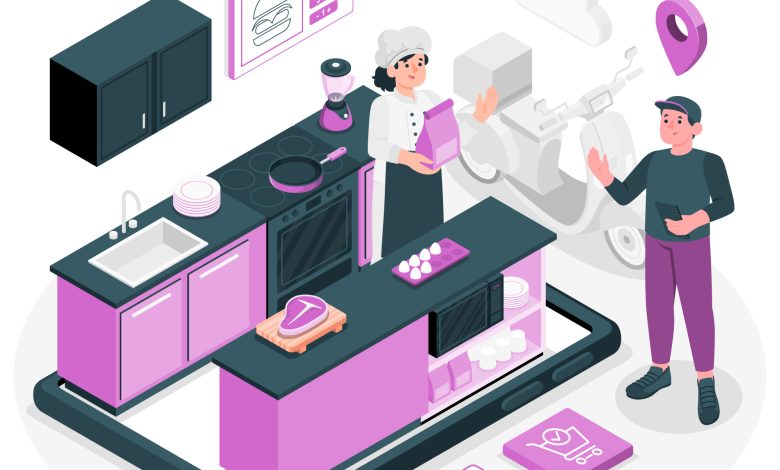The Rise of Virtual Restaurants: Operating a Cloud Kitchen from Home

The food industry has witnessed a revolution in recent years with the rise of virtual restaurants and cloud kitchens. These innovative business models allow entrepreneurs to operate fully online, offering food delivery without the need for a traditional brick-and-mortar restaurant. Virtual restaurants are ideal for chefs, culinary enthusiasts, and entrepreneurs who want to launch a food business with lower overheads and greater flexibility. This guide will explore how you can start and operate a cloud kitchen from home, covering everything from setup to marketing strategies.
1. What is a Virtual Restaurant?
A virtual restaurant, also known as a ghost kitchen, dark kitchen, or cloud kitchen, is a food service business that operates exclusively online. Unlike traditional restaurants, virtual restaurants have no dine-in area and focus solely on preparing meals for delivery or pickup. Orders are typically placed through food delivery apps like Uber Eats, DoorDash, or Just Eat, making the process convenient for both the restaurant and its customers.
Benefits of Virtual Restaurants:
- Low Overheads: No need for expensive rent and utilities for a dine-in space.
- Flexible Operations: Operate from a commercial kitchen, a rented space, or even a home kitchen (where regulations allow).
- Adaptability: Easily adjust the menu based on demand and customer preferences.
The virtual restaurant model is perfect for food entrepreneurs who want to reduce startup costs and reach a wider audience without the logistical challenges of a physical restaurant.
2. Understanding the Cloud Kitchen Model
Cloud kitchens are a specific type of virtual restaurant setup designed to optimize delivery-only services. They are often shared kitchen spaces rented out by multiple virtual brands, allowing each to operate independently within the same facility. Some cloud kitchens operate from home kitchens, depending on local regulations, making it feasible for entrepreneurs to run a virtual restaurant from home.
Key Features of Cloud Kitchens:
- Delivery Focused: All meals are prepared for takeaway or delivery.
- Efficient Workflow: Designed for quick meal preparation and packaging.
- Shared Spaces: Some cloud kitchens use shared kitchens to reduce costs.
Operating a cloud kitchen from home can be an efficient way to test your business idea, lower your investment, and scale your brand over time.
3. Steps to Start a Cloud Kitchen from Home
Starting a cloud kitchen from home involves careful planning and consideration. Here’s a step-by-step guide to launching your virtual restaurant.
Step 1: Check Local Laws and Licensing Requirements
Operating a food business from home may be subject to local health and safety regulations. Check with your local government or food safety authority to understand the necessary permits and licenses. In the UK, for instance, you may need to register as a food business with your local council and undergo food hygiene training.
Common Requirements Include:
- Food Business Registration: Necessary in most places for legal operation.
- Food Hygiene Certification: Demonstrates safe food handling practices.
- Home Inspection: Ensures your kitchen meets health and safety standards.
Step 2: Design a Unique and Scalable Menu
Creating a unique menu is essential for standing out in the crowded food delivery space. Focus on dishes that are both popular and travel well for delivery, as food can lose quality during transport.
Menu Tips:
- Focus on Popular Dishes: Identify trending food items in your area.
- Optimize for Delivery: Choose dishes that maintain texture and quality.
- Keep it Simple: A streamlined menu ensures efficient preparation and consistency.
Experiment with a few dishes initially to gauge customer preferences before expanding your offerings.
Step 3: Invest in the Right Equipment
Operating a cloud kitchen requires investing in equipment that can handle consistent orders and maintain food quality. Since you’ll likely operate from a home kitchen, make sure you have appliances that can meet higher demand.
Basic Equipment Needs:
- Quality Cooking Equipment: Reliable ovens, stoves, and other essentials.
- Food Packaging Supplies: Durable containers that keep food warm.
- Food Safety Equipment: Gloves, sanitizers, and thermometers to ensure hygiene.
Step 4: Sign Up with Food Delivery Platforms
Registering with food delivery platforms is a great way to reach customers without investing in your own delivery infrastructure. Most platforms provide a large customer base, making it easier to start generating orders quickly.
Popular Platforms to Consider:
- Uber Eats: Offers a wide customer base and easy setup for businesses.
- Just Eat: Great for local reach and visibility.
- DoorDash: Known for quick delivery times and flexible payment options.
Partnering with multiple platforms can increase visibility and boost orders, but consider the associated commission fees.
Step 5: Market Your Virtual Restaurant
Effective marketing is key to attracting customers and building a loyal client base for your cloud kitchen. Since your restaurant operates solely online, your marketing strategy should focus on digital channels.
Marketing Tips:
- Social Media Presence: Use Instagram, Facebook, and TikTok to share photos, promotions, and updates.
- Google My Business: List your business for local SEO, making it easy for customers to find you.
- Incentives: Offer discounts or loyalty programs to encourage repeat orders.
Consider using influencers or partnering with local food bloggers to expand your reach.
4. Maintaining Quality and Consistency
One of the biggest challenges for cloud kitchens is maintaining food quality, especially since customers are only experiencing your product through delivery. Focus on consistency and packaging to ensure that each order meets customer expectations.
Quality Tips:
- Test Recipes: Make sure recipes work well in bulk preparation and hold up in delivery containers.
- Standardise Ingredients: Use the same suppliers to maintain consistency.
- Invest in Quality Packaging: Use packaging that keeps food warm and prevents spills.
Good reviews and consistent quality can help your virtual restaurant stand out and encourage positive word-of-mouth.
5. Benefits of Operating a Cloud Kitchen from Home
Operating a cloud kitchen from home offers unique benefits, particularly for those looking to enter the food industry with limited investment.
Top Benefits Include:
- Lower Startup Costs: No need to invest in a full-scale restaurant setup.
- Work-Life Balance: Operate from home with a flexible schedule.
- Growth Potential: Easily scale or pivot the menu based on demand and customer feedback.
With careful planning and a strong commitment to quality, a home-based cloud kitchen can be a successful business venture that allows you to make a profit from your culinary skills.
6. Challenges and How to Overcome Them
While the cloud kitchen model has many advantages, there are challenges to consider, especially when operating from home.
Common Challenges Include:
- Compliance with Health Regulations: Always stay up-to-date with local health guidelines.
- Managing High Order Volumes: Ensure you can handle demand, especially during peak times.
- Building Brand Recognition: Use digital marketing to establish a strong online presence.
By anticipating these challenges and planning ahead, you’ll be better equipped to run a successful cloud kitchen.
Conclusion
The rise of virtual restaurants and cloud kitchens has transformed the food industry, providing a unique opportunity for entrepreneurs to operate delivery-only businesses with lower costs and greater flexibility. Starting a cloud kitchen from home allows you to test your culinary skills, reach a large audience, and grow a profitable business without the overhead of a traditional restaurant. Follow these steps, stay committed to quality, and enjoy the journey of building a virtual restaurant from your own kitchen.





